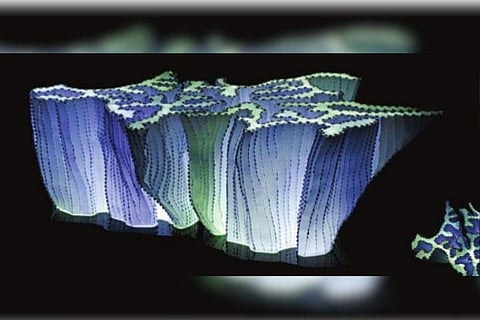
- LIFESTYLE
- FASHION
- FOOD
- ENTERTAINMENT
- EVENTS
- CULTURE
- VIDEOS
- WEB STORIES
- GALLERIES
- GADGETS
- CAR & BIKE
- SOCIETY
- TRAVEL
- NORTH EAST
- INDULGE CONNECT

First impressions may not always be the last; definitely not for architect Rajat Sodhi’s new installation, Khôral. It is recommended to take a beat to appreciate the three translucent hollow paper sculptures that replicate corals. A patient viewing reveals that they breathe, at least seem to. It is the customised light, placed along the bottom edge of the two-and-a-halffeet tall structures, glowing meditatively, that does the trick. “I programmed it to 4.1 seconds, to mimic the average human breath pattern,” Sodhi says. He adds the idea behind the artwork, exhibited by Delhi’s Pulp Society, was to redirect attention to the environmental catastrophe that we are headed towards.
The Delhi-based architect runs Orproject, an architecture and planning company with offices also in Beijing and London, with Christoph Klemmt, Assistant Professor at the University of Cincinnati, US. Their practice is centred on creating an “eco-narrative”. Khôral was made using algorithm-based computational design to “bio-mimic and grow similar forms, structures and spaces”.
They used mathematics to draw coral diagrams on a computer and then recreated it physically. The sculptures are made by joining multiple strips of ivory paper that have tiny trapezoid flaps (14,000 in all) along the edges, each of which Sodhi manually stuck to join the strips. It is through the perforations between the flaps that the light diffracts, and as it alternates between bright and dim intensities (in shades of blue, pink and yellow), it appears to travel up and down the coral’s body, creating an illusion of it breathing.
“Most people find mathematics boring because it’s repetitive. But, it’s amazing to see how plotting the relationship between certain numbers in a logical manner can give you such organic possibilities,” Sodhi says.
A real-time example of this would be the Busan Opera House, in South Korea, based on Klavierstück I, a piano composition. Using a computational algorithm, the notes of the musical piece are transformed into repetitive strips that are layered to form the structure’s façade. A second-generation architect, Sodhi comes from a family of farmers in Punjab. And while he did follow in his father’s footsteps, he believes that the knack for “growing things”, which he inherited from his forefathers, has come to define his practice.
“Growth is about something becoming bigger, and I have a particular fascination for growing architectures. Say there’s one cell, you divide it into two, then into four, and it starts to become bigger, a more organised system of sorts. I am interested in looking at things from that perspective––what that organisation is, and its qualities. Finally, the resulting information is encoded,” the 41-year-old says.
Over the years, Sodhi and Klemmt have grown trees, butterfly wings and cancer cells. Their practice is, however, more than just creating stimulating installations that reimagine the human relationship with the environment. Through their research in the intersectional space between art and architecture, they also explore possibilities of ecological infrastructure.
For instance, through the butterfly wings, grown as part of the Bubbles project, they propose the idea of an enclosed park in a city. Housing a botanical garden, the air inside would be temperature- and humidity-controlled, with high purity levels. Its applications can be extended to enclose playgrounds, school yards, and other spaces.
With Khôral, Sodhi says, the structure can be extrapolated into actual “zero-waste” buildings using 3D printing. The computational algorithm allows the construction to be precise, without any trial and error in real-time. “Construction currently is a wasteful process,” he says, adding “With 3D-printing, a fluid and continuous form of the Khôral, generated layer by layer, emerges, and it does not need flaps for connections, making it a zero-waste process.”